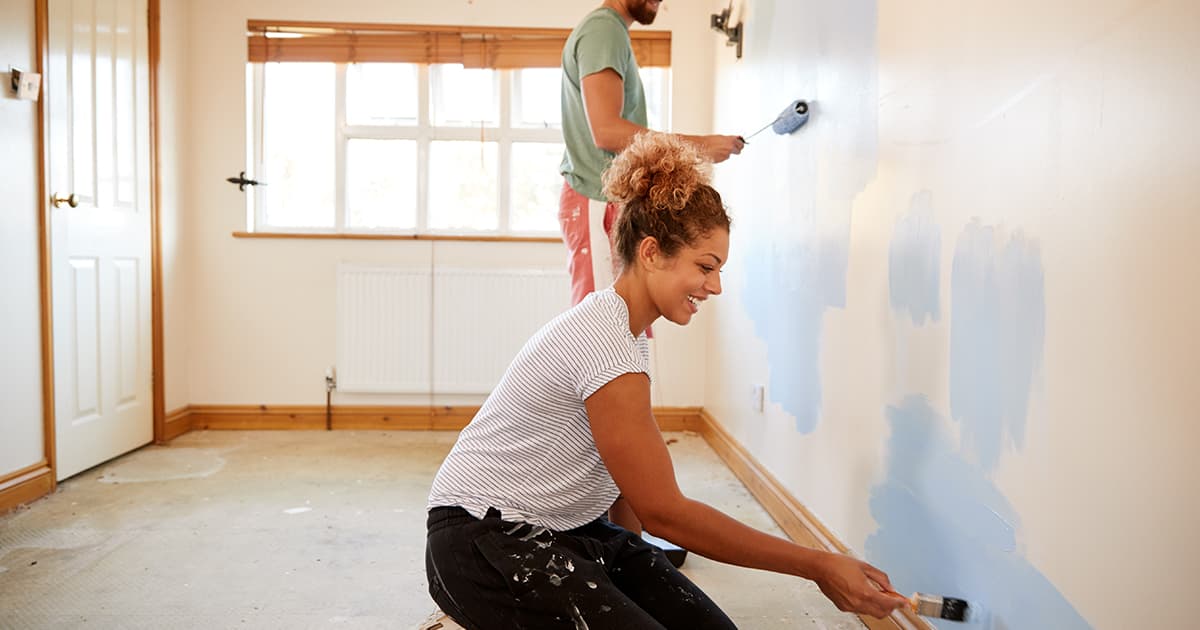How to Paint a Room or Hire a Painter

A fresh coat of paint can update your home in a big way with minimal cost. Here is how to do it yourself or find the right professional.
How to paint a room
Your home will need to be painted at least every 10 years or so. It is easy to do yourself when you prep a room correctly, have the right supplies, and follow the steps for painting walls and ceilings properly.
1. Prep the room
Preparing a room for painting is the first step and will make the job much easier.
- Remove furniture, light fixtures, outlet covers, blinds, and HVAC registers.
- Fill holes with plaster and allow to dry. Sand the repaired areas with 220-grit sandpaper or a sanding sponge.
- Wipe surfaces with a damp towel or sponge and let them dry.
- Ventilate the room and wear a respirator mask if the paint fumes will be strong.
- Wear old clothes.
2. Use painter’s tape
Mask trim, windows, and doors with painter’s tape. Choose the right kind of tape for the surface you will be painting.
- Press tape into place to prevent seeping.
- Stick tape at the edge of the wall in short, overlapping strips.
- If you are painting the walls but not a textured ceiling, make a smooth edge on the ceiling with a screwdriver for the tape to stick to.
- If you are painting an accent wall, mask off the inside edge.
3. Spread drop cloths
Protect the floor with drop cloths.
- Canvas drop cloths are absorbent, reusable and durable.
- Plastic is cheaper but not absorbent and spills can be tracked around the room.
- Paper tears easily when placed on the floor and is better for covering furniture and lights.
4. Start with the ceiling, then the walls
Start painting at the top of the room with the ceiling. Do the edges first with a brush then you can use a roller for the rest of the ceiling. Once the ceiling is finished, do the edges of the wall with a brush, and then roll them.
If you are painting a light color over a darker one, you need to prime the walls first. Paint and primer are available in one.
- Paint 2 or 3 inches along windows, corners, and edges of the wall. “Cutting in” this way helps keep paint uniform. After painting the edges, you should paint the rest of one small area.
- Choose the right roller cover for the wall you are painting and use a roller to paint the area you have cut in.
- Paint in 3-foot by 3-foot sections and work top to bottom in V- or W-shaped strokes. Get even coverage and avoid drips.
- If the wall shows through, you will need another coat.
- After the primer dries, sand bumps and ridges with fine grit sandpaper.
- Wipe the walls clean with a damp towel.
5. Paint the walls
Paint one wall at a time and blend wet paint that you have brushed around the edges with the paint you are rolling.
- Work from top to bottom using V- or W-shaped strokes.
- Roll over the section you have just finished in continuous top-to-bottom strokes to catch drips and cover lines.
- Overlap areas you have already painted and lightly lift the roller off the wall to prevent end marks.
- Mix your paint every time it sits for a while.
- Wait 2-4 hours between coats of paint.
- Store your roller in a plastic bag so it does not dry out.
6. Clean up
Remove paint from floors and surfaces and clean your tools
- Remove painter’s tape just before or right after the paint dries to avoid residue.
- Carefully remove paint drips with paint thinner.
- Seal paint cans tightly.
- Clean rollers and brushes with warm, soapy water.
- Remove drop cloths and replace furniture.
Hiring a painter
If you will be painting a large portion of your house or just do not have the time to paint, hire a professional painter.
- Ask friends and neighbors to refer a painter they are happy with and do some research online. Read some reviews and select 3-4 painters with whom you would work.
- A good painter should be punctual, return calls quickly and answer your questions.
- They should not demand payment upfront. They may ask for a deposit but not the entire amount.
- They should have business cards, contracts, and a work schedule.
- The painter you choose should offer a warranty or guarantee on their paint and work.
- They should provide an estimate.
- Confirm whether you are paying by the hour or for the full job.
- They should help you choose up-to-date colors that work well with the lighting in your home.
Signs of a good painter
- A good painter should take the time to prepare the room or surface they will be working on. For outdoor work, the surface should be scraped, and power washed.
- The painter should mask windows, doors, and furniture, and, if they are painting outdoors, cars, concrete, pavers, and anything else that could be damaged.
- The painter should use top-quality paint.
- A good painter will have professional tools for a cleaner look than what you could achieve yourself.
- It is ok to mix water into paint to dilute it unless it is waterproof paint.
- Your painter should check their work even before you do.



.jpg?300x300)